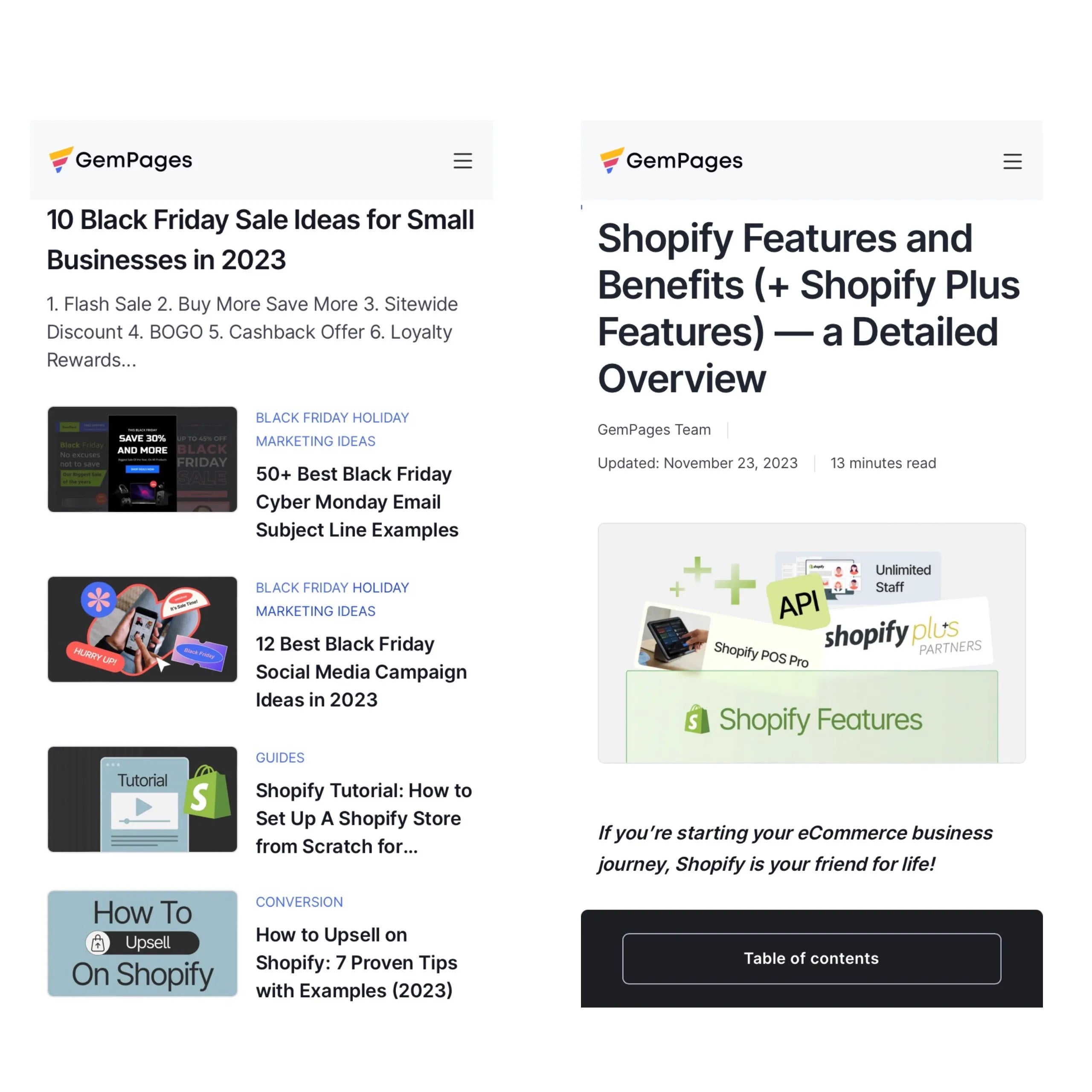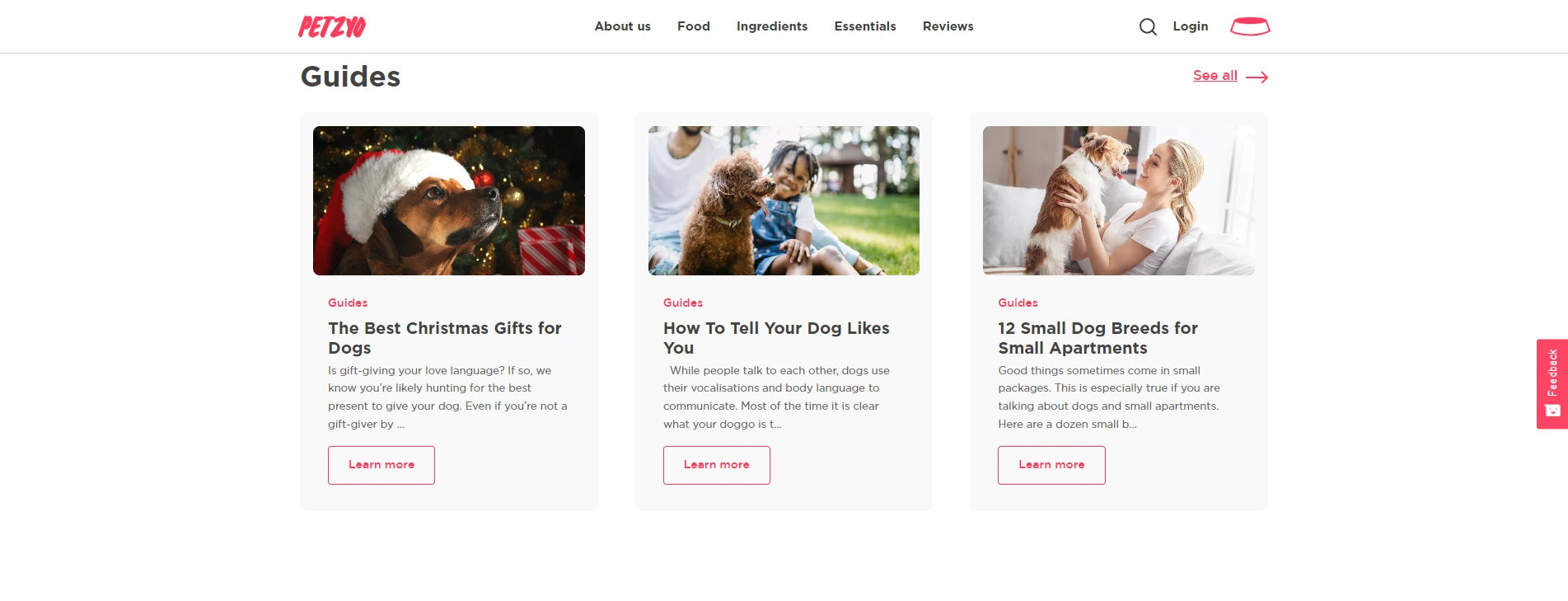Tired of
lengthy page building?
Try GemPages to create pages faster and smarter with AI-powered feature.
Try GemPages to create pages faster and smarter with AI-powered feature.
Exclusively for users making any first payment from Oct 1st to Dec 31st 2023, UTC.
Discount applied automatically at checkout.
Thank you for subscribing.
You will be the first to know about new releases, giveaways, special projects, and everything we promised.
Your email is already used.
Looks like you already signed up for GemAcademy Premium using this email address.
Stay in the know
Subscribe and you'll be the first to know about Shopify news, profitable store ideas, helpful guides, product updates, and more.

The eCommerce scene has seen substantial changes in the past decades, and it is constantly changing. Being a business owner is a multifaceted job, as simply selling and shipping products does not cut it any longer.
Since your website is the mothership, every page needs equal attention to keep the engine running smoothly. While the product page and home page might prevail in most cases, the MVP for creating content is the blog page.
In this digital era, blogging goes beyond writing down what’s on your mind. Search engine optimization (SEO) is a factor that every content creator should take note of. So, how exactly does it work in an eCommerce setting? Learn how to write a blog post for SEO through the best practices, all in our article.

Online shopping is not only about making purchases since blog writing is an integral part of a successful eCommerce business.
Let’s touch on the basics before we get to the meat and potatoes.
A blog, in its primary definition, is an informative website or web page that contains text entries written by an individual or a group of people. Blogs take the form of personal, lifestyle, travel, educational, and in relevance to our topic at hand, eCommerce business.
In fact, what you are reading right now, is a blog post from GemPages.
SEO, or search engine optimization, is the process of improving the quality of one’s website and web page to boost its visibility on search engines.
Shopify is a hotbed for creating great blog posts that not only promote your products but also cater to SEO and drive traffic to your store. Better yet, these visits are completely organic without the help of paid ads. In other words, the magic of efficient blog content is in your hands. By learning what is SEO-friendly, you will know exactly what to do.
Let’s get into the details below.
Similarly to its basic definition, eCommerce SEO is the practice that enhances an online store’s performance, thus increasing its ranking on search engine results pages (SERPs).
The ultimate goal of eCommerce SEO is the organic traffic of visitors who come across one’s online store through relevant searches.
How exactly does this work?
As a customer, when you put in a keyword search on Google, you are directed to the SERP. Stores that include the same keyword on their web page will pop up as the first results. With blog content, the keyword queries might be a little bit more specific since the topics vary.
For instance, an affordable perfume store can create SEO-friendly blog content about “The Best Perfume Dupes” - a popular inquiry among its customers. If its blog post satisfies this query, the brand’s ranking will be improved.
Let’s get to the benefits of SEO in content writing, and why you will want to start looking into optimizing your content based on this process.

SEO is an unmissable criterion that no blog writer should neglect.
It is reported that organic search makes up about 33% of overall traffic to eCommerce sites. While this number is not staggering, it is a telltale sign that young startups whose budgets are limited can focus on creating SEO-friendly content, instead of splurging on paid ads. The fact that over 50% of consumers discover new brands through Google searches is also one of the benefits of utilizing SEO as a part of your marketing strategy. There is a reason SEO practices are being widely promoted across different fields.
There are several ways to go about this, and updating your blog content regularly is one of the most effective methods to stay active and on par within your niche.
By pumping out hot topics, you can also get ahead of your competitors. Through blog updates, customers will more likely remember your brand and products, in comparison with competitors who do not put themselves out there as much.
As much as blogging is a tool to gain visits, it is also an excellent channel to engage with your long-standing and new customers.
Blog posts that provide useful, educational, and captivating information about your business or the industry are the type of content that your customers seek the most. These blog posts are extremely versatile and can be constantly updated to stay on beat with the market.
Not every lead will convert into sales, and we’re here to tell you that it’s a common occurrence. Let’s look on the bright side: every visit is an exposure to your brand’s mission.
Blog, after all, is a neat gateway to get your message and vision across. Especially if you are an eCommerce store, blogging is a worthwhile opportunity to transmit your brand’s message. If your content pops up on a customer’s search results page, you have the answer to their concern. That is a great sign to keep creating content that helps your future clients and organically grow your business.

This is the main event, where we will tell you what to and not to do when it comes to Shopify blog for SEO. The tips below are applicable across all eCommerce niches, but needless to say, there are specific alterations that you can benefit from within your industry. Let’s jump in.
This point is obvious, but unmissable. A valuable blog post does not mean there should be keywords galore at every corner, or one with a trendy title but the content just barely glazes the topic. Here are some tips for you to create actual content that grows your brand:
Getting potential clients to visit your online store is one thing, but keeping them on the page is a separate challenge. Learning to reduce the dreaded bounce rate is important for every business owner.
For blog posts, the anatomy cannot be overlooked. A wordy article with unclear titles is no one’s favorite read. Instead, put yourself in the visitor’s shoes to figure out what they actually want to see.
Our recommended components for a blog page include: a scannable outline, user-friendly layout, reasonable length, and clear navigation.
We have been using the term “keyword” loosely throughout this article. In reality, each page of your online page possesses a different set of keywords.
For example, the product page is optimized to drive sales, hence words like “buy” and “purchase” with clear product titles will help rank your store higher.
With the blog page, the content is more data-focused. Instead of addressing keywords such as “where to buy peanut butter”, blog posts aim to target queries like “is peanut butter good for you”.
Checking what users are searching for and generating a list of keywords should be on your checklist. Websites like Semrush and Ahrefs will give you a helping hand during this phase.
Pro tip: add long-tail keywords for a higher conversion value.

Other content forms that add visual value to your blog posts are highly advisable.
One lengthy and continuous page of text strains our eyes, especially when looking at a blue-lighted screen. Make sure to break each paragraph up and add exciting visuals to combat this.
For an eCommerce store that carries its own products, there is no shortage of photographs. The use of visual elements will even breathe life into blog posts which are a bit mundane.
Mix up images, videos, GIFs, infographics, illustrations, etc. with your blog posts to convey compelling and appealing content.
Meta titles and meta descriptions may seem trivial compared to other components of a blog post, but they are crucial elements for on-page SEO. While a meta title is a summary of a web page on SERP, a meta description is a short description that displays right alongside it. These conjoined factors stand side-by-side to determine the click-through rate of your potential customers, thus, remember to incorporate them into your blog content.
Link-building, in this context, refers to the internal links that lead visitors to other pages on your online store.
By organizing your blog posts by theme, you will be able to add internal links between ones that are related. Google can also find and index your store’s pages more easily. This way, important pages will gain more visibility by page authority.
We have gone over the benefits of this practice, and here is how to get this tactic to work in your favor:
You might run into a dilemma where other pages on your website receive the attention they deserve, except for the blog page where you poured your heart out in every post. Ouch!
To increase visits to your blog page, you can opt to promote your content on social media, via newsletter, or reserve a “check out our blog” section on other pages. There is no need to overdo it, but directly advertising your blog posts is a neat tactic to keep your store active.
In this era when Google can display millions of results in half a second, having a slight delay in your page’s loading time can be fatal. Blog posts often contain heavy-weighted visuals, thus, be sure to assess your page’s loading speed with tools, namely PageSpeed Insights up your ranking on SERPs.

GemPages’ blog posts are optimized for a seamless mobile reading experience.
Mobile optimization is one criterion that should not go unnoticed by business owners, in this day and age where digital natives are the majority. As more and more people shop on their mobile phones, they will definitely check out your blog posts on this palm-sized device as well. This is why it is advised that your blog page has a mobile-friendly interface, with details such as readability, easy-to-click CTA buttons, pop-up minimization, and so on.
More from GemPages: 11 Best Shopify Blog Examples You’ll Want to Copy


Fluxies’ blog posts are not just about their products, they focus on women’s health - its core customers, as well.
We always come back to Fluxies as one of the prime examples of blogging done right.
As a period panties company, Fluxies does not shy away from discussing all things period and women’s health. The blog posts are not just about advertising their products, they cover every aspect of menstruation, down to the most taboo topics. The tags vary from advice, and environmental, to mental health, myths & facts, and so on.
Every post contains clear headings, useful internal links, a keynote thumbnail, an open comment section, and above all, informative and trustworthy content.
Fluxies also keeps their articles short and sweet. The right amount of information is provided without crowding the page.
Overall, this store knows how to create content that shines through topics that are not out of the left field.

passionfruit uses its blog posts to advocate for LGBTQIA+ rights.
One look at passionfruit’s Shopify store can tell us exactly what their vision is.
With advocating for LGBTQIA+ rights at its core, this inclusive clothing brand dedicates a standalone page for blogging, and they are not just any type of blog.
As you click on the page, you are greeted with a conspicuous statement: This is where the Passionfruit team showcases and curates all things queer.
This summary gives us a clear picture of what passionfruit’s blog posts are all about. Forget promoting products and staying on top of trends, the brand uses blogging as a means to educate and share stories revolving around the community. The posts are kept concise, with stated sources, a comment section, and visual elements.
This is one way of creating blog content on Shopify that resonates with customers in its most authentic form. If your business follows the same principle, this approach could work for you as well.
Saying Petzyo’s blog page is exceptional is an understatement. This company does not only carry one of the best dog foods in the market but it also knows what the customers want, and promptly delivers.
The blog posts are cleverly sectioned. Customers can juggle between different topics right on the top of the page, or simply scroll down and choose an article to start reading.
Each of these blog posts is incredibly well-written, with a reasonable length, interesting visuals, user-first navigation, and a nifty “Recommended articles” at the bottom of the page.

Petzyo makes sure its customers are provided with an all-around news source to take better care of their furry friends.
As there is a plethora of pet food brands on the market, this blog corner sure gives Petzyo an edge over competitors who do not pour as much effort into blogging as it does. Customers are more prone to engage with the brand regularly, through reading their blogs and eventually, making a purchase.
eCommerce is not a new term, but its nature is forever evolving. Catching up with the current shifts helps your business stay fresh and relevant.
Blog writing is a mighty tool that helps your business grow naturally, especially when SEO is factored in as a core element. Though this is not a one-and-done deed, it is definitely worth investing your time and efforts in.
This Shopify blog for SEO guide from GemPages is for business owners of all stages and skill levels who are looking to master their blogging game. If you find this article helpful, consider checking our eCommerce Blog & Marketing Tips for the latest news on everything eCommerce and Shopify.
